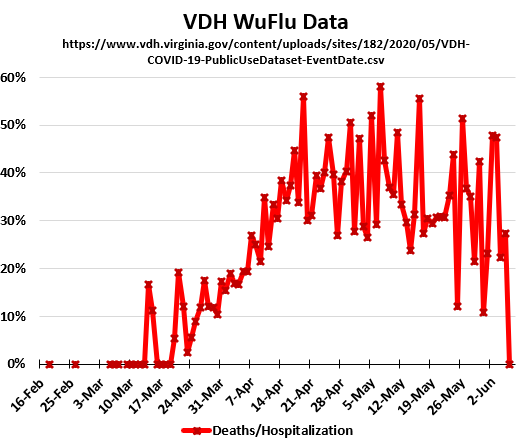The COVID-19 data is looking great. Time to partaaaay!
Just kidding, boys and girls, we do not need another Ozark pool-party moment. You still need to wear your masks and keep your social distance. But the evidence does suggest that Virginia can quickly wind down many of the remaining restrictions on business activity.
Despite occasional spikes (likely due to the vagaries of data collection), the number of confirmed COVID-19 cases continues to head down. The percentage of confirmed cases reached 487 yesterday, the lowest in almost eight weeks. The percentage of positive tests hit a near-low of 8.9%. Indeed, so few people are displaying COVID-19/flu-like symptoms that even the number of tests is declining. Governor Ralph Northam wanted a minimum of 10,000 tests daily. Virginia has the capacity, but people just aren’t getting them. What if they threw a COVID-testing party and nobody came?
The best news of all may be that hospitals, doctors and pharmaceutical companies are doing a better job of treating the disease. In countries with modern health care systems, COVID-19 is becoming less deadly.
From the Wall Street Journal:
The hospitalization death rate is heading down. Not only are fewer people testing positive for the virus, fewer are likely to die from it. The fact is, doctors and hospitals are learning which treatments are effective and which are not.
[An Italian] study finds that the novel coronavirus has become less lethal over the past few months. While there’s no evidence that mutations are making the virus less deadly, treatments have improved enormously as scientists have learned more….
[The] study confirms anecdotes from expert physicians that “the early administration of more tailored medications, is considerably improving the clinical course of COVID-19.” Doctors are using a cocktail of targeted therapies including repurposed HIV antivirals, anticoagulants and monoclonal antibodies like tocilizumab that lower inflammatory cytokine attacks on organs. …
We now know, for instance, that deaths among severely ill patients often result from an overreactive immune response known as “cytokine storms” as well as systemic blood clots. The Food and Drug Administration this week approved a new blood test by Roche that measures levels of the inflammatory-causing protein interleukin-6 and can help predict patients at risk for cytokine storms. Using drugs to break up blood clots and calm down the immune system earlier can prevent severe cases from turning deadly.
Doctors have also observed that some patients with fatally low oxygen levels aren’t gasping for air or losing consciousness and their symptoms resemble altitude sickness—dizziness, nausea and headaches—more than pneumonia or acute respiratory distress. As a result they are using less intensive ventilation such as nasal cannulas and sleep-apnea machines. …
The FDA last month approved Gilead’s antiviral remdesivir for emergency use after a phase-one trial found that the drug reduced recovery times in hospitalized patients on average to 11 days compared to 15 days for those in a control group. Remdesivir stops the virus from replicating, so it may be even more beneficial if administered earlier in the illness.
The treatment learning curve has been as steep as the infection curve. But even if there’s a second Covid-19 wave, it is likely to be less deadly than the first.
Virginia data is consistent with the notion of a declining fatality rate.
The chart below, provided by John Butcher, expresses the number of daily deaths as a percentage of daily hospitalizations. The percentage peaked in late April, early May in the 30% to 50% range. Although the percentage is volatile, it clearly has been falling since.




